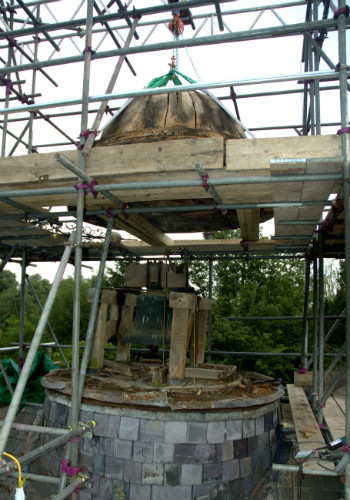
On a summer’s day there’s nothing quite like stripping off and now even our cupola - our bell tower - has been stripped back to its birthday suit and beyond! Now we can see the bells properly for the first time since the belltower was built in 1799.
It was thought that John Fidel, ‘builder and upholsterer’ of Faringdon, rehung the old bells from the previous church. If he had he would certainly have had to have them recast: the churchwardens in 1745 said “Our church and tour (tower) are in good order but one of our bells is craked which we will repair as soon as we can.” Only a year later in 1746 they said, “second bell is not in repair for it hath a small crack that hindereth the sound”. Nothing was in fact done and by 1796 the church was being prepared for demolition.
John Fidel in his first detailed plans intended to have just one bell and which was to be a recast one. Perhaps he was trying to keep the total bill down? The original legacy from John Blandy, of Kingston House, in 1736 provided £2000 for the demolition and rebuilding of the new church but later, after some disappointing investments, this was whittled down. John Fidel’s first estimate was £1,150 4s 4d! The final bill came in at around £700.
Fidel’s design for the bell tower reads, “To put on a Circular Terratt (turret) for Bell with Collumns Cornices and Dome roof Lubber (Louvre?) Boarding as Design with a Oak bell Frame and one Bell a floor under Do. Covered with Lead the Top of the Terratt Coverd with Lead. . . To recast and hang the bell paint all the Wood . . . . . “

Fidel commissioned John Rudhall to make a new bell. Or, as it says on one of the bells, I Rudhall Glocester Fect
. 1799 – which is a Latinised version of ‘J Rudhall Gloucester made 1799’. John Rudhall (1759-1835) took over his father’s bell foundry in 1783 but it was said somewhat inauspiciously that “there is no doubt that he was the least able of this renowned family of bellfounders and not a great businessman either.” However, both of our bells have hung for over 200 years without too much incident.
We can presume that the treble bell is the older, probably, recast one. The National Bell Register notes that one bell (the tenor) was made in 1799 but gives no date for the other so it is feasible that the treble could have been recast from an older one. A survey of 1926, made rather difficult because of Fidel’s difficult access, noted a chime of two small bells - tenor 20 inches and treble twelve inches in diameter. Bell metal is a type of bronze made from 78% copper and 22% tin. This combination ensured a long life with the required resonance and attractive sound calling the faithful to prayer and announcing services and celebrations.
So our bells, having seen the full light of day for the first time in over 200 years are now back in circulation and hopefully will ring out again for centuries to come with nothing to “hindereth the sound!”
